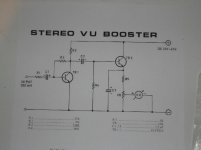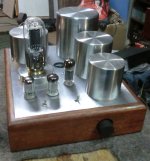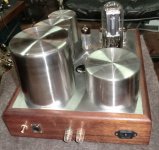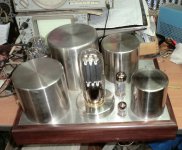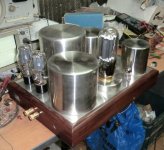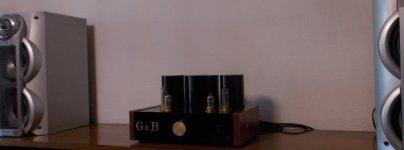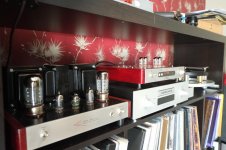Nice done Dimitris, I'm interesting in how you connect VU meter circuit? I want to do with my VU too.
I didn't connect it yet , but I find this simple circuit in the net , it's a vu booster , will connect it in the output of the preamp via a high resistance value , because I don't want this circuit to affect the preamp output ! .
Attachments
I didn't connect it yet , but I find this simple circuit in the net , it's a vu booster , will connect it in the output of the preamp via a high resistance value , because I don't want this circuit to affect the preamp output ! .
Thanks Simitris, I thought same way.
This is my last work.
This is the initial amplifier.
MM has two entrances and two universal inputs.
Exit 1B.
Power anodes - a vacuum regulator.
Retention rate + - 1%, the level of -70 dB background.
Heating tubes strengthen -germanievye semiconductors and current stabilizer.
Driving classic MM equalizer 12AX7 tube (6N2P)
Tubes linear part ECC88 (6N23P)
Tubes powerful part 5Ц4С 6Ф6С СГ3С 6Г2
Resistors: Welwin, capacitors CDE Budrok.
The high-power capacitors Tesla oil, and Black Gate Rubycon.
Overload level Linear + 20dB, the background level of -70 dB line.
The background level equalizer - 50dB.
The same wire used Siemens and the old RCA. Tranformator old Dinako.
Drossel Telefunken.
Chassis laser cutting, aluminum, argon welding.
Very inspiring me, thank for sharing.
Very inspiring me, thank for sharing.
There is a desire to watch scheme?
finished blocks on the 845 tube . in tract no resistors and capacitors
is that hammond wood chassis ?
looks too damn good
Yes, it is solid wood. here is a mono amplifier is not over. from solid rosewood. 845 tube
Pans are not over yet in the Russian Federation?
Hi!
My amplifier on SU-17. Schematic PP (Komarov S. UA3ALW). Output transformers homemade. Output power 2 x 8 Watts. At the level of 1 dB 27 Hz - 22 kHz
View attachment 487031
Komarov use transformers with trash military technologies. It transformers for power, are not suitable for sound. Do not tell lies about gorgeous performance.
Please, explain Why.....I know Komarov....Komarov use transformers with trash military technologies. It transformers for power, are not suitable for sound. Do not tell lies about gorgeous performance.
my parallel 4P1L SET....
6J9 triode wired input stage, 6N1P broskie cathode follower..
6J9 triode wired input stage, 6N1P broskie cathode follower..
An externally hosted image should be here but it was not working when we last tested it.
An externally hosted image should be here but it was not working when we last tested it.
An externally hosted image should be here but it was not working when we last tested it.
An externally hosted image should be here but it was not working when we last tested it.
An externally hosted image should be here but it was not working when we last tested it.
An externally hosted image should be here but it was not working when we last tested it.
An externally hosted image should be here but it was not working when we last tested it.
Just finished my first amp build. More Photos
How do the lil' Tannoy's sound with the SSE?
With solid state amps I always felt the bottom end was too transparent (if that makes sense). Basically no matter how the bass freqs sat in a mix these Tannoys would make it sound good and clean. As soon as you played the track on another pair of speakers or in the car the bass would be all over the place. After a few days listening to my new amp with these speakers I've found they reproduce the lows more accurately now. Actually I think everything sounds more accurate. I've been running it UL mostly. There's definitely a tube characteristic (warmth) to the sound, but I like that.
The Tannoys were designed for near-field monitoring, and don't have too much lows to begin with. With the SSE, you are probably hearing a bit more lows as compared to the SS amps, since the lows are less damped. As long as you are enjoying the sound, that's what matters.With solid state amps I always felt the bottom end was too transparent (if that makes sense). Basically no matter how the bass freqs sat in a mix these Tannoys would make it sound good and clean. As soon as you played the track on another pair of speakers or in the car the bass would be all over the place. After a few days listening to my new amp with these speakers I've found they reproduce the lows more accurately now. Actually I think everything sounds more accurate. I've been running it UL mostly. There's definitely a tube characteristic (warmth) to the sound, but I like that.
Very good work, and why the choice 4P1L?my parallel 4P1L SET....
6J9 triode wired input stage, 6N1P broskie cathode follower..
An externally hosted image should be here but it was not working when we last tested it.
An externally hosted image should be here but it was not working when we last tested it.
An externally hosted image should be here but it was not working when we last tested it.
Heated DC?
The Tannoys were designed for near-field monitoring, and don't have too much lows to begin with. With the SSE, you are probably hearing a bit more lows as compared to the SS amps, since the lows are less damped. As long as you are enjoying the sound, that's what matters.
I actually do use them as near field monitors in my studio although I've never totally relied on them. The picture above is actually in my dining room right after I finished the amp. So far I am enjoying the sound, but I still have a lot of different settings to live with and a few tubes to roll.
A couple of my latest creations. A poweramp and a preamp, former running 6550 or KT88 in single ended triode, the latter has a bunch of ECC88's. I made the preamp just because I wanted a remote control after all these years running between the listening chair and equipment rack to adjust volume.
Attachments
- Home
- Amplifiers
- Tubes / Valves
- Photo Gallery
